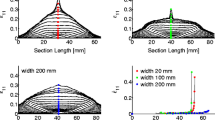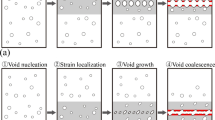Abstract
In this study, the numerical simulations of sheet metal forming processes are performed based on a fully coupled elastoplastic damage model. The effects of stress triaxiality and Lode angle are introduced into the damage evolution law to capture the loading-path-dependent failure. The proposed constitutive model is implemented into the finite element (FE) code ABAQUS/Explicit via the user-defined subroutine (VUMAT). Next, the identification procedure for DP780 based on the hybrid experimental–numerical method is presented in detail. The numerical results of simple tests are compared with the experiments, and obvious improvement is observed for the proposed model under various loading paths. Finally, the model is applied to predict the edge fracture during sheet blanking process. The predicted global load–displacement responses and crack paths have a good agreement with the experimental results, indicating that the model holds great potentials in simulation of metal forming processes.











Similar content being viewed by others
References
Freudenthal AM. The inelastic behavior of engineering materials and structures. New York: Wiley; 1950.
Bai Y, Wierzbicki T. A new model of metal plasticity and fracture with pressure and Lode dependence. Int J Plast. 2008;24(6):1071–96.
Xue L, Wierzbicki T. Ductile fracture initiation and propagation modeling using damage plasticity theory. Eng Fract Mech. 2008;75(11):3276–93.
Lou Y, Huh H. Prediction of ductile fracture for advanced high strength steel with a new criterion: experiments and simulation. J Mater Process Technol. 2013;213(8):1284–302.
Gu B, He J, Li S, Lin Z. Anisotropic fracture modeling of sheet metals: from in-plane to out-of-plane. Int J Solids Struct. 2020;182–183:112–40.
Lemaitre J. A continuous damage mechanics model for ductile fracture. Trans ASME J Eng Mater Technol. 1985;107(1):83–9.
Gurson AL. Continuum theory of ductile rupture by void nucleation and growth: part I—yield criteria and flow rules for porous ductile media. J Eng Mater Technol. 1977;99(1):2–15.
Needleman A, Tvergaard V. An analysis of ductile rupture in notched bars. J Mech Phys Solids. 1984;32(6):461–90.
Chang Y, Jiao G, Zhang K, Wang B, Ju J. Application and theoretical analysis of C/SiC composites based on continuum damage mechanics. Acta Mech Solida Sin. 2013;26(5):491–9.
Badreddine H, Labergère C, Saanouni K. Ductile damage prediction in sheet and bulk metal forming. Comp Ren Méca. 2016;344(4–5):296–318.
Cao TS, Gachet JM, Montmitonnet P, Bouchard PO. A Lode-dependent enhanced Lemaitre model for ductile fracture prediction at low stress triaxiality. Eng Fract Mech. 2014;124–125:80–96.
Yue Z, Cao K, Badreddine H, Saanouni K, Gao J. Failure prediction on steel sheet under different loading paths based on fully coupled ductile damage model. Int J Mech Sci. 2019;153–154:1–9.
Zhang K, Badreddine H, Saanouni K. Ductile fracture prediction using enhanced CDM model with Lode angle-dependency for titanium alloy Ti-6Al-4V at room temperature. J Mater Process Technol. 2020;277:116462.
Malcher L, Mamiya EN. An improved damage evolution law based on continuum damage mechanics and its dependence on both stress triaxiality and the third invariant. Int J Plast. 2014;56:232–61.
Saanouni K. Damage mechanics in metal forming: advanced modeling and numerical simulation. Hoboken: Wiley; 2012.
Zhang K, Badreddine H, Saanouni K. Thermomechanical modeling of distortional hardening fully coupled with ductile damage under non-proportional loading paths. Int J Solids Struct. 2018;144:123–36.
Wang K, Luo M, Wierzbicki T. Experiments and modeling of edge fracture for an AHSS sheet. Int J Fract. 2014;187(2):245–68.
Wang K, Wierzbicki T. Experimental and numerical study on the plane-strain blanking process on an AHSS sheet. Int J Fract. 2015;194(1):19–36.
Acknowledgements
This work is supported by the Fundamental Research Funds for the Central Universities (20CX06023A), Qingdao Postdoctoral Applied Research Program (QD20190014), National Natural Science Foundation of China (No. 11802131) and Key R&D Program in Shandong Province (2019GHZ001).
Author information
Authors and Affiliations
Corresponding authors
Rights and permissions
About this article
Cite this article
Zhang, K., Wang, M., Liu, W. et al. Fracture Prediction for an Advanced High-Strength Steel Sheet Using the Fully Coupled Elastoplastic Damage Model with Stress-State Dependence. Acta Mech. Solida Sin. 34, 263–273 (2021). https://doi.org/10.1007/s10338-020-00185-w
Received:
Revised:
Accepted:
Published:
Issue Date:
DOI: https://doi.org/10.1007/s10338-020-00185-w




